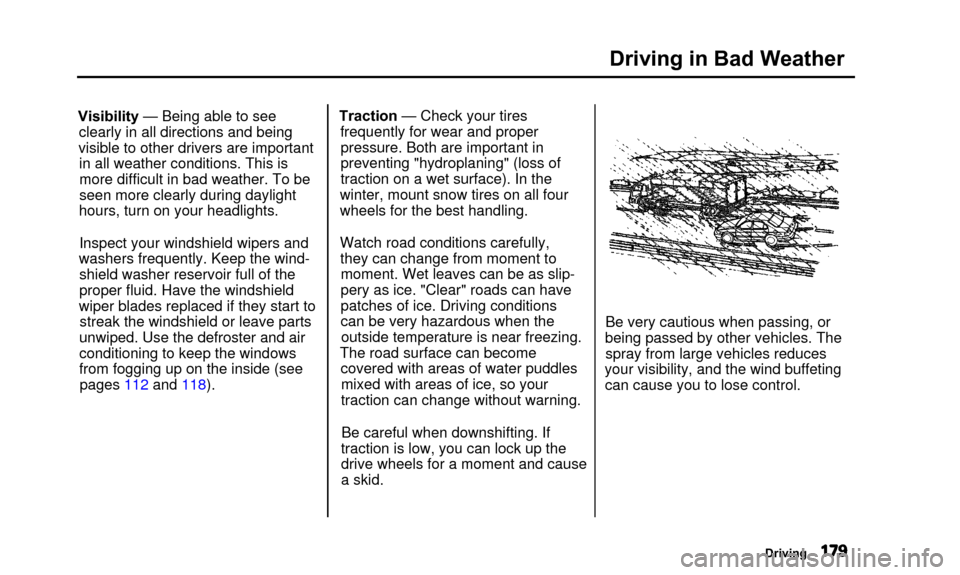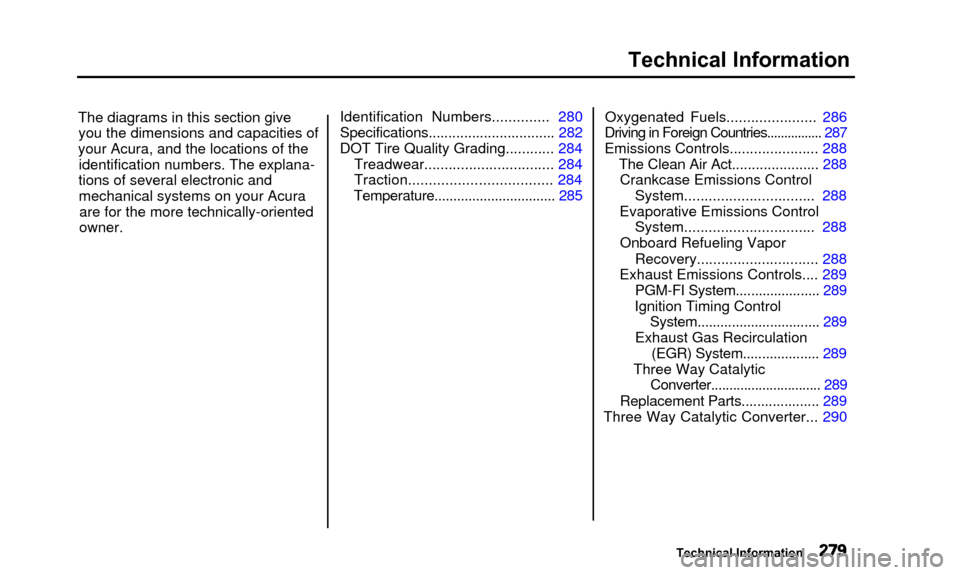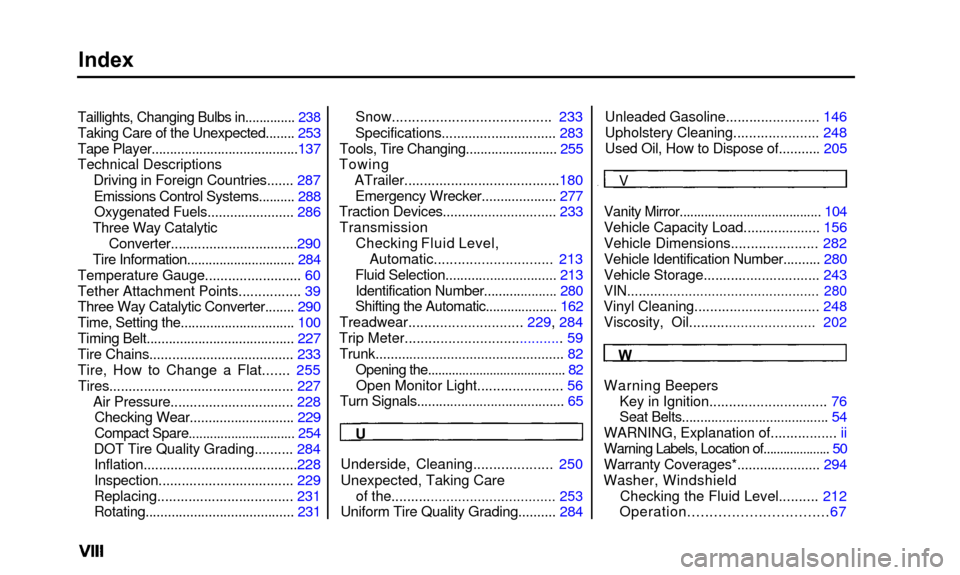traction control Acura TL 2000 3.2 User Guide
[x] Cancel search | Manufacturer: ACURA, Model Year: 2000, Model line: TL, Model: Acura TL 2000Pages: 311, PDF Size: 3.05 MB
Page 182 of 311

Driving in Bad Weather
Visibility — Being able to seeclearly in all directions and being
visible to other drivers are important in all weather conditions. This is
more difficult in bad weather. To be
seen more clearly during daylight
hours, turn on your headlights.
Inspect your windshield wipers and
washers frequently. Keep the wind- shield washer reservoir full of theproper fluid. Have the windshield
wiper blades replaced if they start to streak the windshield or leave parts
unwiped. Use the defroster and air
conditioning to keep the windows
from fogging up on the inside (see pages 112 and 118). Traction — Check your tires
frequently for wear and properpressure. Both are important in
preventing "hydroplaning" (loss of
traction on a wet surface). In the
winter, mount snow tires on all four
wheels for the best handling.
Watch road conditions carefully, they can change from moment tomoment. Wet leaves can be as slip-
pery as ice. "Clear" roads can have
patches of ice. Driving conditions
can be very hazardous when theoutside temperature is near freezing.
The road surface can become covered with areas of water puddlesmixed with areas of ice, so your
traction can change without warning.
Be careful when downshifting. If
traction is low, you can lock up the
drive wheels for a moment and cause
a skid. Be very cautious when passing, or
being passed by other vehicles. The spray from large vehicles reduces
your visibility, and the wind buffeting can cause you to lose control.
Driving
Page 183 of 311

Towing a Trailer
Your Acura has been designedprimarily to carry passengers and
their cargo. You can use it to tow a
trailer if you carefully observe the
load limits, use the proper equipment, and follow the guidelines in thissection. Load Limits
• Total Trailer Weight: The total
weight of the trailer andeverything loaded in it must not
exceed 1,000 lbs (450kg).Towinga load that is too heavy can
seriously affect your vehicle's
handling and performance. It can also damage the engine and
drivetrain.
• Tongue Load: The weight that the tongue of a fully-loaded trailer
puts on the hitch should be
approximately 10 percent of the
trailer weight. Too little tongue
load can make the trailer unstable and cause it to sway. Too much
tongue load reduces front-tire
traction and steering control. To achieve a proper tongue load,
start by loading 60 percent of the
load toward the front of the trailer and 40 percent toward the rear, then
readjust the load as needed.
Driving
Page 282 of 311

Technical Information
The diagrams in this section giveyou the dimensions and capacities of
your Acura, and the locations of the identification numbers. The explana-
tions of several electronic and mechanical systems on your Acuraare for the more technically-orientedowner. Identification Numbers
.............. 280
Specifications ................................ 282
DOT Tire Quality Grading ............ 284
Treadwear................................ 284
Traction................................... 284
Temperature................................ 285 Oxygenated Fuels
...................... 286
Driving in Foreign Countries ................ 287
Emissions Controls...................... 288 The Clean Air Act ...................... 288
Crankcase Emissions Control System................................ 288
Evaporative Emissions Control System................................ 288
Onboard Refueling Vapor
Recovery.............................. 288
Exhaust Emissions Controls.... 289 PGM-FI System...................... 289
Ignition Timing Control System................................ 289
Exhaust Gas Recirculation (EGR) System.................... 289
Three Way Catalytic Converter.............................. 289
Replacement Parts .................... 289
Three Way Catalytic Converter... 290
Technical Information
Page 287 of 311

DOT Tire Quality Grading (U.S. Cars)
The tires on your car meet all U.S.Federal Safety Requirements. All
tires are also graded for treadwear,
traction, and temperature perform-ance according to Department of
Transportation (DOT) standards.
The following explains these gradings.
Uniform Tire Quality Grading Quality grades can be found where
applicable on the tire sidewall
between the tread shoulder and the maximum section width. For
example:
Treadwear 200
Traction AA
Temperature A Treadwear
The treadwear grade is a compara-
tive rating based on the wear rate of
the tire when tested under controlledconditions on a specified government
test course. For example, a tire
graded 150 would wear one and one
half (1-1/2) times as well on the
government course as a tire graded 100. The relative performance of
tires depends upon the actual condi-
tions of their use, however, and may depart significantly from the norm
due to variations in driving habits,
service practices, and differences in
road characteristics and climate. Traction
The traction grades, from highest to
lowest, are AA, A, B, and C. Those
grades represent the tire's ability tostop on wet pavement as measured
under controlled conditions on specified government test surfaces
of asphalt and concrete. A tire
marked C may have poor traction
performance.
Warning: The traction grade assigned to this tire is based onstraight-ahead braking traction tests,
and does not include acceleration,
cornering, hydroplaning, or peak
traction characteristics.
Technical Information
Page 309 of 311

Index
Taillights, Changing Bulbs in.............. 238
Taking Care of the Unexpected........ 253
Tape Player........................................137
Technical Descriptions
Driving in Foreign Countries....... 287
Emissions Control Systems.......... 288
Oxygenated Fuels....................... 286
Three Way Catalytic
Converter.................................290
Tire Information.............................. 284
Temperature Gauge......................... 60
Tether Attachment Points................ 39
Three Way Catalytic Converter........ 290
Time, Setting the............................... 100
Timing Belt........................................ 227
Tire Chains...................................... 233
Tire, How to Change a Flat....... 255
Tires................................................ 227
Air Pressure................................ 228
Checking Wear............................ 229
Compact Spare.............................. 254
DOT Tire Quality Grading.......... 284
Inflation........................................228
Inspection................................... 229
Replacing................................... 231
Rotating........................................ 231
Snow........................................ 233
Specifications.............................. 283
Tools, Tire Changing......................... 255
Towing
ATrailer........................................180
Emergency Wrecker.................... 277
Traction Devices.......... .................... 233
Transmission Checking Fluid Level,
Automatic.............................. 213
Fluid Selection.......... .................... 213
Identification Number.................... 280
Shifting the Automatic.................... 162
Treadwear............................. 229, 284
Trip Meter....................................... . 59
Trunk......... ........................................ . 82
Opening the......... .............................. . 82
Open Monitor Light...................... 56
Turn Signals....................................... . 65Unleaded Gasoline..........
.............. 146
Upholstery Cleaning...................... 248
Used Oil, How to Dispose of.......... . 205
U
Underside, Cleaning.......... .......... 250
Unexpected, Taking Care
of the.......................................... 253
Uniform Tire Quality Grading.......... 284
V
Vanity Mirror........................................ 104
Vehicle Capacity Load.......... .......... 156
Vehicle Dimensions...................... 282
Vehicle Identification Number.......... 280
Vehicle Storage.............................. 243
VIN.................................................. 280
Vinyl Cleaning................................ 248
Viscosity, Oil................................ 202
W
Warning Beepers Key in Ignition......... ..................... 76
Seat Belts......... .............................. . 54
WARNING, Explanation of......... ........ ii
Warning Labels, Location of......... ........... 50
Warranty Coverages*.......... ............ 294
Washer, Windshield Checking the Fluid Level.......... 212
Operation................................67